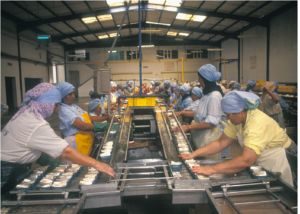
Women in fish processing plant. Photo: FAO
This FAO publication is a very welcome addition to the material on the problems and solutions to gender inequality all along fish supply chains. Good practice policies to eliminate gender inequalities in fish value chains, by Jennie Dey de Pryck analyses the facts, as they are known and provides guidance to action to address the inequalities across the sector, in small scale fisheries and aquaculture and in industrial fisheries. The publication also illustrates, with good examples and cases, the points and practices being proposed.
Download the publication here: Good practice policies to eliminate gender inequalities in fish value chains
From the Foreword:
The purpose of this paper is to highlight some key gender inequalities in fisheries and aquaculture value chains that lead to marked under performance by women and to propose some good practice policies that can lead to sustainable increases in production, processing and marketing of high-quality fish, increase women’s and their families’ incomes, and reduce malnutrition among the poor. The paper … aims to build a solid business case to convince policy-makers and other stakeholders of the benefits of exploiting the hidden economic and social potential of fisheries and aquaculture. The focus is on developing countries where the majority of fish workers live, although some of the issues are similar in industrialized countries. The main audience is government policy-makers and officials, researchers, and their various development partners involved in the fisheries sector, with a particular focus on producers’, workers’, employers’ and other stakeholder organizations, including community-based organizations, operating in the formal or informal fisheries and aquaculture sector. Concerted, coordinated efforts are clearly essential among all these stakeholders to address the issues and realize women’s lost potential in fisheries.
Contents:
1. GENDER INEQUALITIES AND WOMEN’S LOST POTENTIAL IN FISH VALUE CHAINS
2. WHY IS GENDER IMPORTANT?
3. GOOD PRACTICES IN CLOSING THE GENDER GAP AND REALIZING WOMEN’S HIDDEN POTENTIAL IN FISHERIES AND AQUACULTURE
4. FUTURE DIRECTIONS
This entry was posted in: Aquaculture, Freshwater Fisheries, Gender, Marine Fisheries, Men, Women
